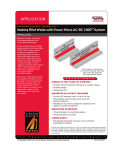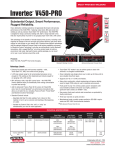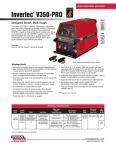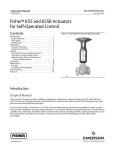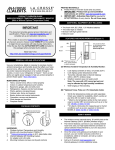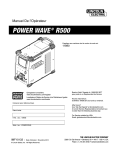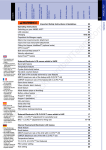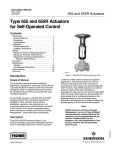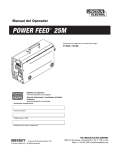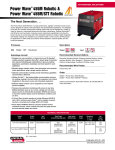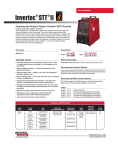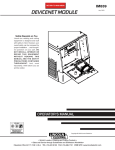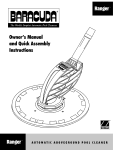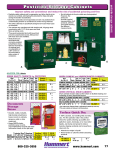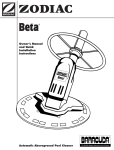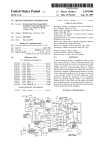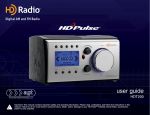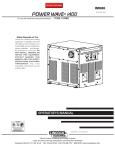Download Lincoln Electric METALUX M340 User's Manual
Transcript
TECHNOLOGY W A V E F O R M C O N T R O L T E C H N O L O G Y T M Waveform Control TechnologyTM Just as computer companies recognize the importance of providing their customers with multi-functional equipment, Lincoln Electric realizes that our customers want the power to choose what fits them best. As companies broaden their product offerings, this desire has turned into necessity. In the past, different equipment has been required for different welds. Customers often needed several models of welding equipment to perform a variety of welding procedures. Waveform Control Technology revolutionizes the way welding equipment is chosen. Waveform Control Technology welding systems support 8 processes, over 80 weld procedures, and the option to fine-tune or develop new welding programs. Waveform Control Technology is available in semi-automatic, hard automation, or robotic systems. We’ve put the power of choice back into the hands of the operators. Choose wisely. Choose Waveform Control Technology. Alterations to the waveform can be made during the weld, using software created by Lincoln Electric. SIMPLIFIED PROCESS SELECTION Metal transfer modes may be controlled to extend the stable operating range of the welding process. ADAPTABILITY Shapes the arc using computer software. A single machine can quickly and easily adapt to: • A wide range of applications • Varying materials specifications • Varied weld positions • Appearance requirements WELD QUALITY Optimized metal transfer reduces spatter and improves arc stability. PRODUCTIVITY Higher deposition rates are possible at heat input equal to or less than traditional CV processes. CUSTOMIZABLE Output parameters may be adjusted for given welding waveform conditions and joint design to meet weld specifications and production rates. T h e f u t u r e o f w e l d i n g i s h e r e .® NX-1.10 11/03 TECHNOLOGY Waveform Control Technology 2/8 What is Waveform Control? Waveform Control Technology is the ability to customize waveform output. It is the ability to choose a weld program from a pre-defined set of programs, and to manipulate the parameters of that program to best fit your application. Lincoln Electric strives to understand the customer’s needs in order to make the job easier. That is why Waveform Control Technology was designed: to empower the people who use the equipment, our customers. The Arc Action Tool shows the behavior of the arc in the form of a Voltage/Amperage (VI) plot. To further illustrate what the changes in voltage and current mean to the arc, Lincoln Electric uses high-speed photography to capture arc behavior. Waveform Control Technology allows the user to choose from a library of pre-programmed weld “modes” that have been developed by expert welders. Then, Waveform Control Technology offers the opportunity to change those values, within a programmed range, to find the combination of wire feed speed, voltage, current, and arc control that the application requires. to use a single source to perform Stick, TIG, MIG/MAG, Flux-cored, and Submerged Arc welding procedures. With a Waveform Control Technology product, the days of configuring different systems to make different welds are over. But Lincoln has even taken it one step further. Waveform Control Technology also provides the ability How Waveform Control Works There are many physical forces that affect the welding arc and the transfer of metal from the electrode to the weld puddle. Surface tension, magnetic, and aerodynamic forces are the most significant. The welding current directly affects the magnetic and aerodynamic forces in the welding arc. The welding current and surface tension forces can be balanced to control metal transfer within the arc. Amperage High-speed electronics monitor the electrical signals from the welding arc and make appropriate changes to the current waveform. The electronics must be fast, accurate, and rugged to control the arc and withstand the harsh welding environment. T h e f u t u r e o f w e l d i n g i s h e r e .® TECHNOLOGY Waveform Control Technology 3/8 Waveform Control Weld Programs Equipped with our most up-to-date welding programs, Waveform Control Technology systems suit the majority of welding applications. The flexibility of choosing from a variety of welding programs not only increases productivity, but also promotes consistently high-quality welds. The programs listed in the following tables were developed by Lincoln Electric.* It is important to note that, although we attempted to provide a broad operating window for each program, they were developed using Lincoln consumables. Therefore, Lincoln Electric cannot guarantee that these procedures will operate at optimum level when used with non-Lincoln Electric electrodes. Power MIG 300, Invertec V350-PRO, and Power Wave welding systems are all Waveform Control Technology systems. They come fully loaded with a software library that is accessible from the user interface. With the Power Wave, software programming enables the flexibility of uploading the weld programs to a PC, or Ethernet and DeviceNet applications (hard automation). A mode number is assigned to each weld program. The following lists include the most commonly used weld programs, and are grouped according to material. Find the mode number for your material and program specifications, then select that mode number on the welding system user interface. General Weld Programs Steel Weld Programs Procedure Description Mode GMAW Standard CV 5 GMAW Power ModeTM 40 FCAW Standard CV 6 STICK Soft (7018) 1 STICK Crisp (6010) 2 TIG Touch Start TIG 3 Constant Current Constant Voltage Process Description GOUGE Process Gas GMAW CO2 GMAW Argon (mix) Wire Size Mode 0.030 0.035 0.045 0.052 0.030 0.035 0.045 0.052 0.030 0.035 0.045 0.052 93 10 20 24 94 11 21 25 95 12 22 26 Pulse (Crisp) Argon (mix) Pulse (Soft) Argon (mix) 0.035 0.045 0.052 14 19 28 STT® (No Tailout) CO2, Argon/CO2 0.035 0.045 109 125 0.030 0.035 0.045 0.052 0.035 0.035 0.045 0.045 0.052 110 110 126 126 13 15 17 18 27 0.035 0.045 109 125 9 STT II CO2, Argon/CO2 Rapid Arc Argon/CO2 ® CO2, Robotic STT Argon/CO 2 Steel Welding Application T h e f u t u r e *These programs may not be available in certain machines. o f w e l d i n g i s h e r e .® TECHNOLOGY Waveform Control Technology Aluminum Weld Programs Process GMAW Pulse Pulse-on-PulseTM Stainless Steel Weld Programs Gas Wire Size Mode Argon 3/64 1/16 3/64 1/16 0.035 0.035 71 73 75 77 148 151 3/64 1/16 3/64 1/16 0.035 0.035 72 74 76 78 149 152 0.035 3/64 1/16 0.035 3/64 1/16 98 99 100 101 102 103 Argon Argon 4/8 Process Gas Wire Size Mode GMAW Argon (mix) 0.030 0.035 0.045 61 31 41 GMAW Argon/He/CO2 0.030 0.035 0.045 63 33 43 Pulse Argon/He/CO2 0.030 0.035 0.045 64 34 44 Pulse Argon/CO2 Pulse Argon/O2 0.030 0.035 0.045 0.030 0.035 0.045 66 36 46 62 32 42 STT® Argon/He/CO2 0.030 0.035 0.045 109 109 125 Alloy Weld Programs Process Gas Wire Size Mode Nickel Pulse Argon/He 0.035 0.045 170 175 Silicon/Bronze Pulse Argon 0.035 192 Metal Core Weld Programs Process Gas Wire Size Mode GMAW Argon/CO2 0.045 0.052 1/16 81 83 85 Pulse Argon/CO2 0.045 0.052 1/16 82 84 86 Aluminum Welding Application T h e f u t u r e Stainless Steel Welding Application o f w e l d i n g i s h e r e .® TECHNOLOGY Waveform Control Technology Using Waveform Control 5/8 Waveform Control Software The amount of current applied in varying time intervals can be charted as a waveform. This waveform characterizes the weld output. Changing specific values during specific periods of the waveform directly affects the characteristics of the weld. Lincoln Waveform Control Technology Welding Systems use high-speed electronics to monitor the electrical signals from the welding arc and make appropriate changes to the current waveform. All the desired factors which control the welding arc from “arc start to arc stop” are written in software. Changes to the waveform can be made in real-time, (that is, during the weld), or after the weld if it is evident that the weld does not meet requirements. WaveDesigner Lincoln Electric created the Wave Designer software program to simplify the operator’s experience with controlling various attributes of the waveform. Wave Designer is a tool that allows the manipulation of current waveforms and arc characteristics with a live welding arc. It can also monitor and analyze the critical parameters of the actual waveform at high resolution. ArcScope The ArcScope utility allows the operator to view the actual arc voltage in real-time. This provides the necessary information to manipulate the arc characteristics to achieve a quality weld. Arc Control: Controlling the Waveform Custom Waveforms Waveform Control Technology Welding Systems provide the operators with a simple control knob, “Arc Control”, also known as “Inductance” or “Wave Control”. It allows the operator to vary the arc characteristics from “soft” to “crisp” in most weld modes. It is adjustable from -10.0 to +10.0, with a nominal setting of 00.0. The following are descriptions of the arc control functions for different weld processes. Customized welding software means even the most difficult materials can be welded with the Power Feed/Power Wave system. Copper, Nickel, and Silicon Bronze are a few of the unusual alloys the Waveform Control system welds with ease when special software is loaded. Lincoln Electric will build custom waveforms for those customers experiencing difficulty with unique materials or joint configurations. Arc Force - (SMAW) Range: -10 (soft) to +10 (crisp) Arc force adjusts the short circuit current for a soft arc, or a forceful driving arc, to prevent sticking and shorting of electrodes. Arc force is especially effective for the root pass on pipe with a stainless electrode, and helps minimize spatter. Wave Designer and ArcScope display real-time readouts of welding arc activity. Pinch - (GMAW CV) Range: -10 (soft) to +10 (crisp) Pinch controls the current applied at a short circuit during short arc welding. Frequency Modulation - (GMAW-PP) Range: -10 (low frequency) to +10 (high frequency) Frequency Modulation controls the spacing of the ripples in the pulse-on-pulse weld. Low frequency modulation is used for slow travel speeds, while high frequency modulation is used for narrower welds. Pulse Frequency - (GMAW-P) Range: -10 (low frequency) to +10 (high frequency) Pulse frequency controls arc “stiffness” The lower the frequency of the pulse, the wider and softer the arc. Trim - (Synergic GMAW, GMAW-P) Range: 0.5 to 1.5 Trim controls the length of the arc. Trim values less than 1.00 decrease the arc length, while values greater than 1.00 increase the arc length. T h e f u t u r e o f w e l d i n g i s h e r e .® TECHNOLOGY Waveform Control Technology 6/8 Process Controls Pulse-On-PulseTM Unlike standard pulse welding, which uses a single pulse wave shape, Pulse-On-Pulse uses a sequence of varying pulse wave shapes to produce a GTAW-like bead appearance to readily produce top quality aluminum welds with excellent appearance, little spatter, and good bead shape. The waveform control in PulseOn-Pulse welding is frequency modulation. Frequency modulation controls the spacing of the ripples in the weld. Use low values for slow travel speeds and wide welds, and high values for fast travel speeds and narrower welds. STT® STT uses current controls to adjust the heat, so changes in electrode extension do not affect heat input. The Waveform Controls associated with STT welding are Peak Current, Background Current, and Tail-Out. Peak current controls the arc length, which affects the shape of the root face; Background current controls heat input, which affects the back bead; Tailout current also contributes to control of heat input. The STT Waveform controls heat input and reduces spatter and fume Power ModeTM The Power Mode uses Power (V x I = W) to regulate the arc length. The preset power setpoint is the main control. Increasing the power setpoint forces the power source to adjust BOTH voltage and current to maintain the watt energy programmed for that setpoint. Increasing the power setpoint will increase voltage and decrease current simultaneously. Tandem MIG Tandem MIG uses two independently generated arcs contributing to the same weld puddle. Tandem MIG can operate in one of two configurations: a lead CV arc with a pulsed trail, or two synchronized pulsed arcs. The Waveform Controls for Tandem MIG are pulse frequency, background current and trim, which control heat input and arc stiffness. The Tandem MIG relies on Waveform Control to synchronize its dual arc system AC/DC Submerged Arc Submerged Arc welding involves as many as five independently generated arcs contributing to the same weld puddle, under a blanket of flux. Waveform Control allows for infinite phase shifting of the AC waveform through the frequency modulation control. Also, ultimate control of deposition and penetration can be obtained by adding positive or negative DC offsets to the waveform. AC/DC Submerged Arc uses Waveform control for infinite phase-shifting to accommodate up to 5 arcs without arc blow T h e f u t u r e o f w e l d i n g i s h e r e .® TECHNOLOGY Waveform Control Products Power Wave 455M Power Wave 455M/STT 7/8 Power Wave 355/Power FeedTM 10M The Power Wave 355 is the smaller, lighter version of the Power Wave 455M – same machine, just leaner and lighter. • The Power Wave 355/Power Feed™ 10M welding system is factory-programmed with over 60 standard welding programs to optimize the arc for a variety of materials or applications, including steel, stainless steel, aluminum, nickel alloys and others. • ArcLink Digital Communication between components allows unprecedented waveform control and expansion capability. Simply select a program and you have the right arc characteristics for your application. • The software is upgradeable, so your Power Wave 355 will grow with your business. If you want to reduce costs by buying a versatile machine that will do multiple jobs and last for years to come, the high efficiency Power Wave 355 delivers. These Power Waves are designed to be part of a modular, multi-process welding system. • The Power Wave 455M and 455M/STT are high performance, digitally controlled inverter welding power sources capable of complex, high-speed waveform control. • Digital Communications enable the Power Wave to connect seamlessly to robot controllers and hard automation PLCs. Semi-automatic applications are also supported. • Optional DeviceNet and Ethernet communication modules provide networking capabilities and allow process and production monitoring. • Software-based controls can be upgraded as new features become available. Power Wave 655R Power MIG 300 The Power Wave 655R was designed for Robotic and Hard Automation applications that require extra power (650 Amps at 100% Duty Cycle) • Digital Communications enable the Power Wave to connect seamlessly to robot controllers and hard automation PLCs. Semi-automatic applications are also supported. • The Ethernet/DeviceNet Gateway provides networking capabilities and allows process and production monitoring. • Software-based controls can be upgraded as new features become available. • The Power Wave 655R has an output range of 20 to 880 Amps. T h e f u t u r e o f w The Power MIG 300 – a single phase, multi-process, synergic power source/wire feeder combination welding package for the professional welder. The Power MIG 300 offers: • Superior multi-process welding. • Synergic design for ultimate control over the arc, by automatically aligning wire feed speed and voltage. • Top-quality aluminum welds with push-pull wire feed capability, not typically available in competitive models. • True MIG pulsing and Pulse-on-Pulse™ capabilities, which ensure that superior feeding is matched by high quality arc performance. e l d i n g i s h e r e .® TECHNOLOGY Waveform Control Products 8/8 WHAT IS NEXTWELD? Power Wave AC/DC 1000 The Power Wave AC/DC is a modular welding system with a single range of control from 100 to 1000 Amps per arc at 100% duty cycle The challenges facing industrial fabricators today are increasingly difficult. Rising labor, material, and energy costs, intense domestic and global competition, a dwindling pool of skilled workers, more stringent and specific quality demands. The Power Wave AC/DC provides: • DC+, DC- and Variable frequency up to 200 Hertz • Flexible Waveform Control • Variable Frequency • Variable independent amplitudes • Variable timing • The Power Wave AC/DC is 100% software controlled Through our commitment to extensive research and investments in product development, Lincoln Electric has established an industry benchmark for applying technology to improve the quality, lower the cost and enhance the performance of arc welding processes. Advancements in power electronics, digital communications and Waveform Control TechnologyTM are the foundation for many of the improvements. Power Wave F355i The Power Wave F355i is fully integrated with the FANUC ARC Mate™ R-J3iB controller and designed for the most demanding robotic applications. • This compact unit delivers 350 Amps @ 60% duty cycle for MIG, Pulsed MIG or Flux-Cored welding applications. • The Power Wave F355i/ARC Mate R-J3iB communicates via ArcLink™, allowing all welding procedures and process controls to be managed through the ARC Mate robot teach pendant – one central control forsetup, process control and diagnostics. NEXTWELD brings you a series of Process, Technology, Application and Success Story documents like this one. NEXTWELD explains how technologies, products, processes and applications are linked together to answer the important questions that all businesses face: • How can we work faster, smarter, more efficiently? • How can we get equipment and people to perform in ways they’ve never had to before? * Ethernet access is available through the Ethernet port of the R-J3iB • How do we stay competitive? NEXTWELD is the future of welding but its benefits are available to you today. Ask your Lincoln Electric representative how to improve the flexibility, efficiency and quality of your welding operations to reduce your cost of fabrication. Customer Assistance Policy The business of The Lincoln Electric Company is manufacturing and selling high quality welding equipment, consumables, and cutting equipment. Our challenge is to meet the needs of our customer and to exceed their expectations. On occasion, purchasers may ask Lincoln Electric for advice or information about their use of our products. We respond to our customers based on the best information in our possession at that time. Lincoln Electric is not in a position to warrant or guarantee such advice, and assumes no liability, with respect to such information or advice. We expressly disclaim any warranty of any kind, including any warranty of fitness for any customer’s particular purpose, with respect to such information or advice. As a matter of practical consideration, we also cannot assume any responsibility for updating or correcting any such information or advice once it has been given, nor does the provision of information or advice create, expand or alter any warranty with respect to the sale of our products. Lincoln Electric is a responsive manufacturer, but the selection and use of specific products sold by Lincoln Electric is solely within the control of, and remains the sole responsibility of the customer. Many variables beyond the control of Lincoln Electric affect the results obtained in applying these types of fabrication methods and service requirement. THE LINCOLN ELECTRIC COMPANY www.lincolnelectric.com 1.216.481.8100 Subject to change - This information is accurate to the best of our knowledge at the time of printing. Please refer to www.lincolnelectric.com for any updated information. T h e f u t u r e o f w e l d i n g i s h e r e .®








